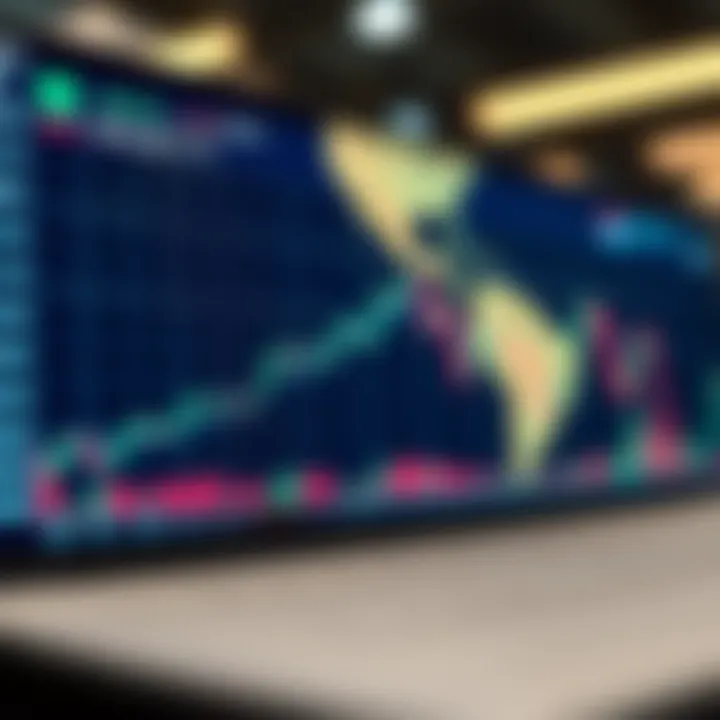Understanding the Latin America Stock Index for Investors


Intro
Navigating the waters of investment in Latin America can feel like stepping into a vibrant, unpredictable mural. The Latin America stock index serves as a compass for investors, guiding them through a landscape rich with opportunities and challenges. This index, not merely a collection of numbers on a screen, represents the pulse of an entire region teeming with economic potential.
Investors often find themselves asking, "What makes this market tick?" or "How can I harness its dynamics to my advantage?" By understanding the components of this index, as well as the underlying factors that sway its performance, one can gain insights crucial for informed decision-making. The purpose of this article is to peel back the layers and explore the Latin America stock index in its entirety, addressing key components, various influences, and strategic approaches that investors can adopt.
Investment Terminology
In the realm of finance, a solid grasp of investment terminology is essential. Without it, navigating complex markets can be akin to driving blindfolded. Here, we will introduce some fundamental terms related to the Latin America stock index.
Key Terms and Definitions
- Stock Index: A statistical measure that reflects the composite value of a selected group of stocks. In the context of Latin America, indices like the Bovespa and Merval illustrate the performance of the largest companies.
- Market Capitalization: The total dollar market value of a company's outstanding shares. It helps in gauging the size of a company.
- Volatility: Indicates how much a market or security may fluctuate in price. Higher volatility often hints at higher risk and potential returns.
- Liquidity: Refers to how quickly an asset can be converted into cash without significantly affecting its price. This is crucial in fast-moving markets.
Common Acronyms in Finance
- ETF: Exchange-Traded Fund. A type of investment fund traded on stock exchanges, similar to stocks, offering a way to invest in a basket of securities.
- IRR: Internal Rate of Return. It estimates the profitability of potential investments, often used to compare the attractiveness of various projects.
- IPO: Initial Public Offering. The first time a company offers its shares to the public, allowing it to raise capital for expansion.
Understanding these terms not only equips investors with the right vocabulary but also enhances their ability to analyze trends and strategies effectively.
Expert Insights
As we delve deeper into the Latin America stock index, it's vital to consider expert insights, which provide a holistic view of the investment strategies that can be successful in this region.
Investment Strategies Overview
- Diversification: Rather than putting all eggs in one basket, investors should aim to diversify across various sectors within Latin America. This could mitigate risks associated with specific industries.
- Research-Driven Approach: For any investor, whether seasoned or new, comprehending both local and global news can influence stock performance. Markets in Latin America can be swayed by political events, economic reforms, or commodity price swings.
- Long-Term Perspective: Many financial experts advocate for a long-term investment horizon. While markets may experience short-term fluctuations, the potential for growth in Latin America over time remains significant.
Tips from Financial Advisors
According to financial advisors familiar with the Latin American markets, here are several practical tips:
- Stay Updated: Continuous learning about the economies and sectors of interest can provide crucial context that informs timely investment decisions.
- Be Wary of Speculative Stocks: While some stocks might appear promising, they may come with unpredictable risks. It's vital to conduct thorough research before committing funds.
- Monitor Currency Trends: Fluctuations in currency can affect the returns from investments. Keeping an eye on exchange rates is essential.
“Involvement in foreign markets, like those in Latin America, is not just about understanding numbers but also about grasping the stories behind them.”
These insights and strategies can equip investors with the knowledge needed to navigate the complexities of the Latin America stock index effectively.
For those interested in diving deeper into specific indices, consider exploring sources such as Wikipedia, Britannica, or investing forums on Reddit. A well-rounded approach will be paramount in capitalizing on opportunities in this dynamic region.
Prelude to Latin America Stock Index
The Latin America stock index holds a crucial role in understanding the financial landscape of a diverse region, encompassing countries like Brazil, Mexico, and Argentina. It serves as a barometer for economic performance, giving investors insight into market trends, growth opportunities, and potential risks. As financial enthusiasts navigate this vibrant yet complex arena, understanding the nuances of the Latin America stock index can be both enlightening and empowering.
Defining Stock Indices
A stock index is more than just a collection of stocks; it represents a snapshot of market performance at any given time. Broadly speaking, indices can be categorized into major types such as price indices and market capitalization-weighted indices. In Latin America, indices like the Bovespa and IPC Mexico highlight the financial health of their respective markets by tracking the performance of selected companies.
These indices are essential for both institutional and retail investors. They offer tools for benchmarking investment performance, gauging economic conditions, and forming investment strategies. A well-defined index can illuminate trends that may not be readily apparent when looking at individual stocks alone.
Historical Context
The historical context of Latin American stock indices traces back to the late 20th century, closely intertwined with the region's tumultuous economic and political changes. For instance, Brazil's stock market was officially established in 1890, but it wasn’t until the 1960s and 70s that significant structural shifts occurred, partly due to international pressures and local market reforms.
The 1980s brought about the so-called "Lost Decade" for many Latin American countries, characterized by hyperinflation and economic instability. However, as countries entered the 1990s, numerous reforms aimed at liberalization opened the doors to foreign investments and improved market accessibility. This era laid the foundation for indices to flourish, with countries like Argentina hosting their own stock exchanges and indices.
Recent history has seen fluctuations tied to global economic trends, including the impact of commodity prices, which remain vital to many Latin American economies. In summary, the evolution of stock indices in Latin America reflects broader economic narratives, making them integral to understanding regional market dynamics.
"The evolution of stock indices in Latin America is not just about numbers; it embodies the shifts in socio-economic conditions, serving as a microcosm of the region’s challenges and triumphs."
With this foundational knowledge of what stock indices are and their historical significance, we move forward to explore major indices currently shaping the Latin American financial landscape.
Major Indices in Latin America
The financial landscape of Latin America is immensely shaped by its stock indices, which serve as barometers of market health and investor sentiment. Understanding these major indices is crucial for both beginners and seasoned investors looking to navigate this vibrant yet complex region. Analyzing these indices helps one grasp broader economic trends, sector performance, and investment opportunities. The indices not only showcase the performance of leading companies but also reflect the unique economic and political climates of each country.
Bovespa Index
Overview


The Bovespa Index, officially known as the Ibovespa, is Brazil's primary stock index and is often regarded as a critical pulse of the Brazilian economy. Comprising over sixty of the most actively traded stocks on the B3 Exchange, it paints a broad picture of market movements. One notable characteristic of the Ibovespa is its market capitalization-weighted structure, which means larger companies hold more sway over index performance. This makes it a popular choice for investors who seek a reflection of comprehensive market dynamics in Brazil.
The unique blend of its components provides an appealing opportunity for domestic and international investors alike. However, a disadvantage could be its heavy reliance on a few large sectors; movements in commodities or banking heavily influence the index’s performance. This concentration might deter investors who prefer diversified risk exposure.
Performance Metrics
When assessing the performance of the Bovespa Index, key metrics like year-on-year growth rates, volatility indexes, and trading volume become fundamental. Investors often look at its historical returns as a measure of resilience against economic downturns. For instance, during the pandemic, the index showcased a rapid recovery, hinting at underlying market strength.
A critical aspect is its price-to-earnings ratio, which investors use to evaluate whether stocks are undervalued or overvalued. While this metric helps in understanding investment potential, it comes with its own quirks; stock market sentiment can skew perceptions leading to potential pitfalls. Hence, careful interpretation is vital for successful investment strategy.
Key Companies
The Ibovespa is home to some of the most influential companies in Brazil, including heavyweights like Petrobras and Vale. These key players not only contribute significantly to the index but also set the tone for investor confidence. Their performance typically correlates closely with international market trends, especially given Brazil's dependence on commodity exports.
For instance, a rise in crude oil prices often boosts Petrobras’ stock, lifting the entire index. However, an overemphasis on these key companies can pose risks, as a decline in their performance could lead to substantial dips in the index. Investors need to balance interest in these dominant firms with the broader market context to navigate potential traps.
IPC Mexico
Index Composition
The IPC (Índice de Precios y Cotizaciones) is Mexico's leading stock market index, consisting of the 35 most liquid shares traded on the Mexican Stock Exchange. This selection represents a diverse range of sectors from telecommunications to consumer goods, thus providing a holistic view of the market. Notably, its method of calculation factors in liquidity, ensuring that the most actively traded stocks influence the index the most.
One advantage of the IPC is that it allows investors to benefit from a balanced exposure to various sectors. However, as with any index, there may be periods where certain sectors dominate. Thus, sector rotation patterns should be carefully monitored to mitigate potential losses.
Investment Implications
Investing in the IPC can yield insightful signals about the Mexican economy's health. Its performance often reflects domestic consumption trends and foreign investments. Notably, clarity around government policy can further dictate IPC movements, highlighting the importance of political stability in investment strategies.
Investors must be aware of the Mexican economy's ties to the U.S. market, as economic health in the United States can dramatically ripple through to the IPC. This interconnectedness can pose risks, particularly during times of geopolitical uncertainty. Understanding these implications is key in formulating a well-rounded investment strategy focused on the IPC.
MSCI Latin America
Global Perspective
The MSCI Latin America Index serves as a crucial link for investors seeking to gain broader exposure to the Latin American markets. Comprising companies from Brazil, Mexico, Chile, and Peru, this index provides a consolidated look into the regional performance across various sectors. Its global perspective makes it an attractive option for investors yearning to diversify their portfolios in emerging markets without needing to track multiple local indices.
One key characteristic of the MSCI index is its systematic approach to capturing growth potential while accounting for risks associated with emerging economies. Its unique packaging of market data can be a double-edged sword; while it presents opportunities for higher returns, it also encompasses higher volatility that investors must manage.
Market Accessibility
The MSCI Latin America Index enhances market accessibility for global investors by offering a clear pathway to engage with the region's best-performing companies. The index's construction follows rigorous guidelines, ensuring that inclusion is based on measurable criteria, allowing transparent evaluation. Many financial products, including mutual funds and ETFs, track this index, making it easier for retail and institutional investors to participate.
Despite these advantages, it's crucial for investors to understand the structural limitations of the index. Changes in constituent companies or index methodology can introduce risks, and hence, continuous monitoring is recommended. Investors should balance their exposure to the index with due diligence on underlying market trends.
In summary, understanding the major indices in Latin America is imperative for making informed investment decisions. The Bovespa, IPC, and MSCI Latin America indices collectively offer unique insights and opportunities. By discerning the characteristics, performance metrics, and the companies behind these indices, investors can navigate the complexities of this dynamic market with greater confidence.
Economic Factors Influencing Performance
Understanding economic factors that influence the performance of stock indices in Latin America is crucial for investors and financial analysts alike. This section outlines the key elements that can either bolster or hinder market performance, enabling informed decision-making in an often unpredictable financial landscape. The interplay between local economies, global trends, and regulatory environments creates a complex fabric of influences that shape investor sentiment and, subsequently, stock prices.
Political Stability
Political stability is a cornerstone of economic growth. In Latin America, countries like Chile and Uruguay have been lauded for their steady political environments, which often correlate with positive market performance. When investors feel that a government can effectively manage policies and uphold the rule of law, they are more likely to invest.
- Investor Confidence: A political climate perceived as stable encourages foreign direct investment (FDI). Investors seek assurance that their funds are safe.
- Policy Continuity: Stable governments can implement long-term economic policies, promoting growth in sectors crucial to the stock market, such as energy and commodities.
However, political turbulence can easily derail this progress. Nations experiencing social unrest or governmental changes may see market volatility soar, making it risky for investors to dive in.
Currency Fluctuations
Currency movements can significantly impact the Latin American stock indices. The region’s currencies, including the Argentine Peso and Brazilian Real, are often vulnerable to external shocks. A few crucial points include:
- Exchange Rate Risk: Investors facing volatile currencies may see their returns diminished when converting profits back to their home currency. A strong dollar against a weak peso, for instance, can erode foreign investors’ returns.
- Inflation and Monetary Policy: Central banks in Latin America often adjust interest rates as a response to currency fluctuations. Elevated inflation can result in a devalued currency, which complicates investment decisions further.
The fluctuating currency environment can create opportunities for gains, but risks abound, making it essential for investors to stay informed about macroeconomic events.
Commodity Prices
Latin America is rich in natural resources. Countries such as Brazil, Chile, and Peru are major exporters of commodities like copper, lithium, and soybeans. Hence, the prices of these commodities heavily influence stock market performance:
- Direct Impact on Earnings: Companies in the mining or agriculture sectors will see their stock prices fluctuate with the global commodity prices. When prices rise, so do profits, which can reflect positively on overall indices.
- Global Demand: A growing global economy often means increased demand for commodities. If China, for example, ramps up its infrastructure projects, commodity prices could rise, positively influencing the entire region.


The link between commodity prices and stock performance highlights the necessity for investors to monitor global markets closely. An uptick in demand or production can signal lucrative investment opportunities.
In summary, multiple economic elements converge to shape the landscape of Latin American stock indices. Political stability fosters confidence, currency fluctuations pose certain challenges, and commodity prices remain a fundamental driver of market performance. Investors must grasp these nuances to navigate the complexities of investing in the region.
Investment Strategies in the Latin America Stock Index
Investing in the Latin America stock index is not just a walk in the park; it requires a clear understanding of various investment strategies. Tailoring strategies to the peculiarities of the region can significantly bolster an investor’s chances of success. By implementing nuanced approaches, investors can better navigate a vibrant yet volatile marketplace, helping to refine their choices based on unique economic circumstances.
Value Investing
Identifying Undervalued Stocks
A key aspect of value investing is honing in on undervalued stocks. This strategy revolves around finding stocks that traders are undervaluing, often due to broader market movements rather than company-specific issues. For instance, a solid company may experience a dip in stock price due to geopolitical risks in its home country. Recognizing these opportunities involves critical analysis, including a close look at financial statements and market positions.
One characteristic that makes identifying undervalued stocks appealing is the potential for price appreciation once market biases adjust. This is often seen in various sectors across Latin America, from consumer goods to energy. While popular amongst investors looking for bargains, the downside here is that it often requires patience. Timing the market rebound can be tricky, and sometimes, investors must brace for prolonged periods of stagnation.
Advantages of this strategy include:
- Lower entry price into potentially profitable companies
- Ability to capitalize on market irrationality
- Long-term wealth accumulation if chosen stocks appreciate over time
Disadvantages may entail:
- Risks associated with prolonged market undervaluation
- Difficulty in stock selection without robust fundamentals
Long-Term Outlook
The long-term outlook is often highlighted as a cornerstone of investment strategies, and rightly so. Investors who adopt this perspective tend to weather short-term fluctuations for the potential of greater gains down the road. In a region marked by volatility, adopting a long-term approach can be especially prudent. An investor might be more inclined to overlook day-to-day market swings if they believe in the foundational strength of a country's economic policies.
The beauty of a long-term outlook lies in its capacity to compound wealth. Over time, even minor annual returns can snowball into significant growth, especially in Latin American economies. However, to fully leverage this approach, one might need to keep a sharp eye on macroeconomic factors, such as commodity prices or international trade relations, that could affect regional stability.
Advantages include:
- Reduced stress from daily market monitoring
- Greater potential for enduring value realization
- Built-in flexibility for adjusting strategies based on new information
However, the disadvantages may involve:
- Exposure to economic downturns while holding assets long-term
- Difficulty in maintaining discipline without immediate rewards
Growth Investing
Targeting Emerging Markets
Next on the agenda is targeting emerging markets. This strategy is particularly timely given the current growth trajectories of many Latin American nations. Investors focusing on emerging markets often seek to tap into industries with high growth potential that can lead to substantial returns. One can look at the technology or renewable energy sectors in various countries, as they are increasingly gaining prominence.
The main allure of this strategy is its forward-looking nature. It relies on recognizing future trends before they occur. Investing in promising sectors can result in significant gains, especially as these industries efforts mature. However, it does bring with it a host of risks, not least the unpredictability of developing markets.
Advantages of targeting emerging markets include:
- Opportunity for high growth compared to developed markets
- Staking a claim in early-stage industries can yield massive returns
- Diversification of investment portfolios with high-reward potential
Conversely, the risks entail:
- Exposure to greater market and economic instability
- Potential difficulty in finding credible information on smaller companies
Potential High Returns
Discussing potential high returns brings us to an enticing yet complex topic. Investors are often drawn by the prospect of higher yields associated with riskier investments. In Latin America, investing in smaller companies or newly emerging industries is often perceived as a golden ticket to substantial yields. These companies can flourish quickly, multiplying investments manifold.
However, while potential high returns can lead to windfalls, the risks cannot be ignored. Many of these investments may not only perform poorly initially but can also lead to losses if market conditions turn south. Thus, while investors can experience immense satisfaction from high-return investments, a sound risk management approach is crucial for sustainability.
Advantages of pursuing potential high returns include:
- The thrill of significant profit margins
- Increased opportunity for wealth generation
Disadvantages often include:
- Heightened risk of loss and volatility
- Need for continuous market monitoring and analysis to avoid pitfalls
In summary, while investment strategies vary widely and depend on an individual’s risk appetite, understanding the nuances of value and growth investing can empower investors to make informed decisions. Specifying strategies to align with the complexities of the Latin American markets can yield fruitful results.
Risks Associated with Investing


Investing in any market carries risks, and the Latin America stock index is no different. Understanding these risks is crucial for both novice and seasoned investors. It forms a cornerstone for making informed decisions that can either yield substantial returns or lead to significant losses. Ignoring these risks may result in unanticipated outcomes that could affect one's financial health.
Market Volatility
Market volatility refers to the degree of variation in a trading price series over time. In Latin America, market volatility can be particularly pronounced due to several factors:
- Economic Conditions: Nations within Latin America can experience rapid changes in their economic conditions driven by inflation, unemployment, and GDP growth.
- Political Events: Political instability, such as changes in government or social unrest, can lead to sharp declines in stock values or increases in volatility.
- Global Influences: Economic factors from global markets can spill over, affecting regional markets dramatically. For example, shifts in commodity prices—a major export for many Latin American countries—can impact local stock indexes significantly.
Considering these factors, one must be prepared for market swings that can occur with little warning. Risk management strategies, such as diversifying investments and employing stop-loss orders, are fundamental in navigating this unpredictability.
"A wise investor understands that while rewards can be plentiful, the risks are ever-present and must be treated with respect."
Regulatory Changes
Investors need to be acutely aware of the regulatory landscape in Latin America, as it can shift quickly. Each country has its own set of regulations governing foreign investment, taxation, and corporate governance. Changes in policies pose several risks:
- Investment Restrictions: New regulations can sometimes restrict sound investment opportunities, making it difficult for foreign entities to invest in the region.
- Tax Policies: Adjustments in tax rates or incentives can alter the attractiveness of certain investments, leading to unanticipated outcomes.
- Compliance Costs: New regulations often come with increased compliance costs, which can eat into profits.
Monitoring regulatory environments and understanding local frameworks is key for any investor interested in entering the Latin American market. Continuous engagement with local financial news and advice from regional experts can mitigate potential pitfalls.
Liquidity Concerns
Liquidity refers to how quickly an asset can be bought or sold in the market without affecting its price. In Latin America, liquidity can be an issue for various reasons:
- Restricted Trading Hours: Stock markets in some countries may have limited trading hours compared to more established markets, impacting the ability to quickly exit positions.
- Low Trading Volumes: Smaller companies or stocks may experience lower trading volumes, which means that it could take longer to buy or sell substantial shares without influencing price movements.
- Market Sentiment Influence: Fluctuating investor sentiment often leads to rapid buy and sell actions, creating a mismatch between demand and supply. This can lead to situations where one could be stuck holding assets that are hard to liquidate without incurring a loss.
Understanding liquidity levels for specific assets within Latin America's stock index is essential. Investors should prioritize stocks that exhibit adequate liquidity to ensure they can respond promptly to market signals without risking significant losses.
By comprehensively analyzing and acknowledging these risks, investors can position themselves to make informed choices, better prepare for unforeseen events, and ultimately improve their outcomes in the dynamic landscape of the Latin America stock index.
The Future of Latin America Stock Index
The future of the Latin America stock index holds substantial relevance for those looking to navigate its intricate waters. As economies evolve, investors find themselves at a crossroads of opportunity and risk. Understanding upcoming trends and long-term projections becomes paramount in crafting informed investment strategies. Not only does it reflect the market’s trajectory, but it also highlights shifts in investor behavior and regional economic health. It’s a landscape full of possibilities for both novice and seasoned investors who seek to tap into this dynamic region.
Emerging Trends
Sustainable Investments
Sustainable investments are rising stars in the financial universe. More investors are weighing environmental and social governance alongside traditional metrics. This shift signals a broader awareness of the impact investments can have, beyond merely generating returns. A key characteristic of sustainable investments is their focus on companies that actively prioritize ethical practices, renewable energy usage, and social responsibility.
One unique feature of this investment approach is the potential for resilience against market volatility. By banking on companies prepared to tackle environmental challenges, investors may find themselves in a stronger position during economic downturns. However, these investments can often come with a price—higher transaction fees or limited options in developing markets can pose challenges. Despite these downsides, the appeal lies in aligning financial growth with a greater purpose, making it a popular choice for conscious investors navigating the Latin American landscape.
Technological Innovations
When we talk about the future, we can't ignore technological innovations. These advancements are reshaping industries across Latin America, influencing everything from banking to agriculture. A major characteristic of these innovations is their ability to increase efficiency and drive growth in emerging markets. Tech startups are leading the charge in streamlining processes and providing greater access to financial resources.
The unique feature here is how technology has democratized investment. With mobile platforms and blockchain technology, more people are finding entry points into the market, especially in regions previously sidelined. The advantages are clear: improved accessibility and expanded market participation. However, it’s not all sunshine and roses; regulatory challenges and cybersecurity risks are valid concerns. Balancing innovation with a sustainable regulatory framework will be essential for ensuring long-term stability in these markets.
Long-Term Projections
Long-term projections serve as a guiding compass in the investment landscape of Latin America. Analysts are closely watching geopolitical dynamics, global economic shifts, and local reforms that can influence this region’s stock index in the coming years. Trends show that as economies stabilize, foreign investment is likely to rise, fostering greater market integration.
With close attention to sustainability and technology, combined with a focus on innovative companies, investors could very well find lucrative opportunities awaiting them. As the markets continue to evolve, remaining adaptable and informed will empower investors of all backgrounds to seize the inherent opportunities within the Latin American stock index.
The End
In pulling together the various strands discussed throughout this article, the conclusion serves as a necessary reminder of the multifaceted nature of the Latin America Stock Index. Whether you're just dipping your toes into investment waters or you’ve been navigating the rapids for some time now, understanding these dynamics is crucial.
Summary of Insights
To put it plainly, the Latin America Stock Index is not merely a collection of numbers; it’s a reflection of the economic health and market conditions across a diverse region. Key insights include:
- Diversity of Indices: From the Bovespa in Brazil to the IPC Mexico, each index tells a unique story about its respective economy and market.
- Investment Strategies: Value and growth investing are not just buzzwords; they represent different approaches to unlocking potential opportunities in the region.
- Economic Factors: Political stability, currency fluctuations, and commodity prices play pivotal roles in shaping the index’s performance, which means staying informed is non-negotiable.
The synthesis of these insights allows investors to draw a clearer picture, guiding their decisions in this dynamic financial landscape. Investors equipped with this knowledge can better navigate the intricacies of the stock indices and capitalize on opportunities that align with their investment goals.
Final Thoughts
As the financial landscape of Latin America continues to evolve, so too does the relevance of the stock index. It stands at a crossroads; while challenges abound, including market volatility and regulatory changes, so do the opportunities for growth and innovation.
Investors should remain vigilant, continuously educating themselves about future trends, and being adaptable to the shifts that inevitably come with investing in emerging markets.
It's worth noting that patience often pays dividends. The Latin America stock index may present short-term volatility, but those who engage with it thoughtfully may discover rewarding prospects that are not evident at first glance. Thus, whether your investment horizon is short or long-term, a well-rounded understanding of the region's stock indices can yield rich rewards.
Investing in Latin America is like navigating a river: sometimes it flows smoothly, and at other times, it plunges into tumultuous rapids. Preparation and knowledge are key to successfully navigating these waters.
As the dawn of tomorrow approaches, the ongoing transformations within the Latin America stock indices are sure to unfold new chapters in the investment narrative. Staying informed and ready to pounce on opportunities could separate success from missed chances in this ever-competitive arena.















